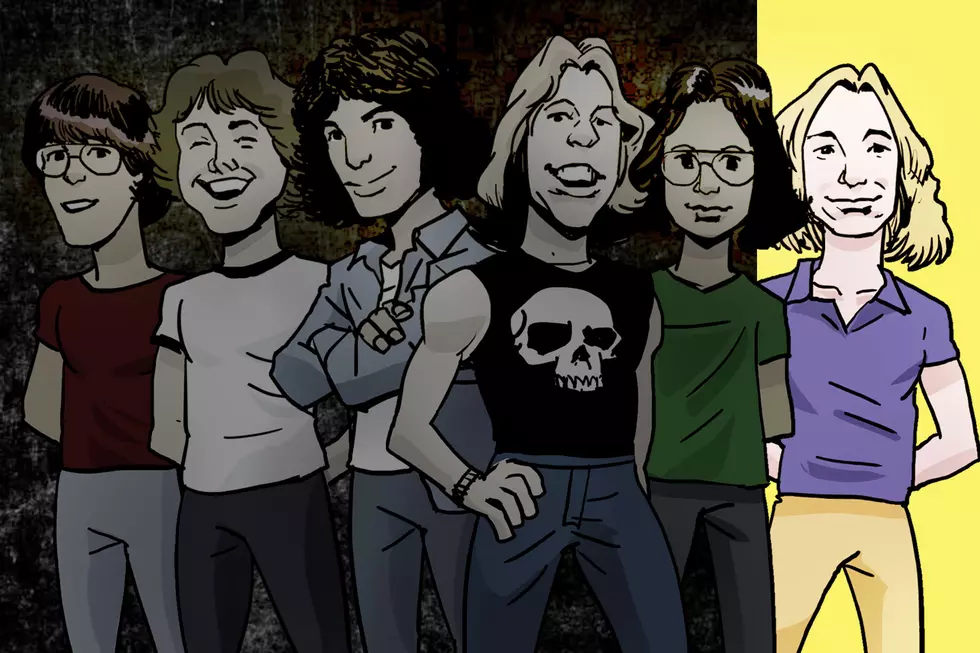
Cliff Burton’s Childhood: Metallica Bassist’s First 72 Seasons
Metallica’s 11th album, 72 Seasons, arrives on April 14. Frontman James Hetfield revealed that the LP’s title and theme revolve around an individual’s formative years. "Seventy-two seasons. The first 18 years of our lives that form our true or false selves,” he explained in a statement. In anticipation of the album, UCR looks back at the respective childhoods of Metallica’s current and former members.
Ray and Jan Burton's youngest child, Cliff, didn't walk until he was almost two. His parents were worried until a doctor told them there was nothing wrong with their son. "He's just smart enough to know that Mom and Dad will carry him around," Ray Burton remembered the doctor saying. "He damn near broke Jan's back!"
Cliff Burton attended the junior high school where his mother taught and was remembered as an introverted kid who preferred the company of a good book or record. "He was a big, big reader, and he was very bright," his mother recalled. "He was a very kind, very gentle kid, but he was always his own person."
Like his parents, Cliff loved classical music and was active outside of school, playing little league baseball and immersing himself in the outdoors, hunting and fishing with a homemade spear. One day he damaged his right pinky while trying to cut a carp he'd caught, severing a tendon that eventually led to a distinct style of playing that would make him one of metal's most beloved bassists.
When Burton was 13, his 16-year-old brother Scott died of a cerebral aneurysm. He didn't discuss his sibling's death much, but friends and family noticed a focused interest in music shortly afterward. "Probably three or four months after Scott died, Cliff came to Jan and me and said, 'Mom and Dad, I want to learn to play the bass,'" Ray Burton said in 2019, recalling that his son wanted to learn the Barney Miller theme. "He said to a couple of people, 'I'm gonna be the best bassist for my brother,'" his mother later remembered.
Building on theory learned in childhood piano lessons and a newfound appreciation for heavier low-enders like Black Sabbath's Geezer Butler and Rush's Geddy Lee, Burton devoted himself to his new instrument.
"Cliff would practice anywhere from six to eight hours a day in his bedroom," his sister Connie remembered in the 2018 film The Salvation Kingdom, a documentary she made about her brother. "If you wanted to talk to him, you had to go into his room. He'd come out, but he'd be carrying his bass. ... And then it would be, 'Come into my bedroom and talk to me, I need to practice.'
"He had a single focus from the time that my brother Scott died," Connie added. "And that focus was to be the best musician he could be."
Cliff took lessons, but his parents said he quickly outgrew his teachers. He found inspiration in anyone from Bach to Stanley Clarke to Lemmy Kilmister, who inspired Burton to pick up a Rickenbacker, on which he installed a Stratocaster pickup to get his inimitable tone. Burton joined his first high school band, EZ Street, with longtime friend and guitarist Jim Martin, who'd go on to play with Faith No More. “Some Faith No More and Metallica songs you are familiar with were germinated during those sessions,” Martin recalled.
"Geezer Butler's right-hand technique involved just hitting the strings with your fingers," Burton's Metallica bandmate Kirk Hammett remembered in 2010. "Cliff called it 'floppy-finger technique' and said he had it, too. He would just use it to hammer the strings and do anything to get a sound out of his bass."
Watch Cliff Burton Perform With Agents of Misfortune
At Castro Valley High School in California, Burton donned a black cowboy hat, bell-bottoms and a jean jacket, ignoring when friends made fun of his fashion. He drove a green Volkswagen Beetle nicknamed the Grasshopper and wouldn't confine himself to any punk, hippie or metal ethos, expressing an appreciation for many artists and lifestyles.
EZ Street took on more of a space-rock sound and emerged with the Blue Oyster Cult-inspired name Agents of Misfortune. In a YouTube clip uploaded in 2011, the trio can be seen playing a battle of the bands in 1981, emitting Hawkwind-inspired noise. At one moment, Burton lets out some heavily distorted riffage with a wah pedal that sounds like his intro to Metallica's "For Whom the Bell Tolls."
Burton studied music at nearby Chabot College, a public community school also attended by Tom Hanks, but he soon felt the urge to move on. He made a deal with his parents, who often came to see him perform: They would support him for the next four years, giving him a chance to make it as a musician. If that didn’t work out, he promised to find a day job.
"He did everything on his own, he knew what he wanted to do," Burton's father remembered, "and by gosh, he went out and did it. How could you not support a child that has that initiative and they're already in their system? And wanting to learn an occupation like that?”
Burton's next shot at greatness came in the San Francisco band Trauma, who opened for Saxon at the Keystone club in Palo Alto, Calif., and landed a song on the 1982 Metal Blade compilation Metal Massacre II. But their most consequential moment came later in 1982 at a show at Los Angeles' Whisky a Go Go, where members of a struggling local band called Metallica watched in awe. "They had a certain look," James Hetfield recalled. "And he was just ... Cliff."
The Most Awesome Live Album From Every Rock Legend
The Rush / Metallica Team-Up That Slipped Away





